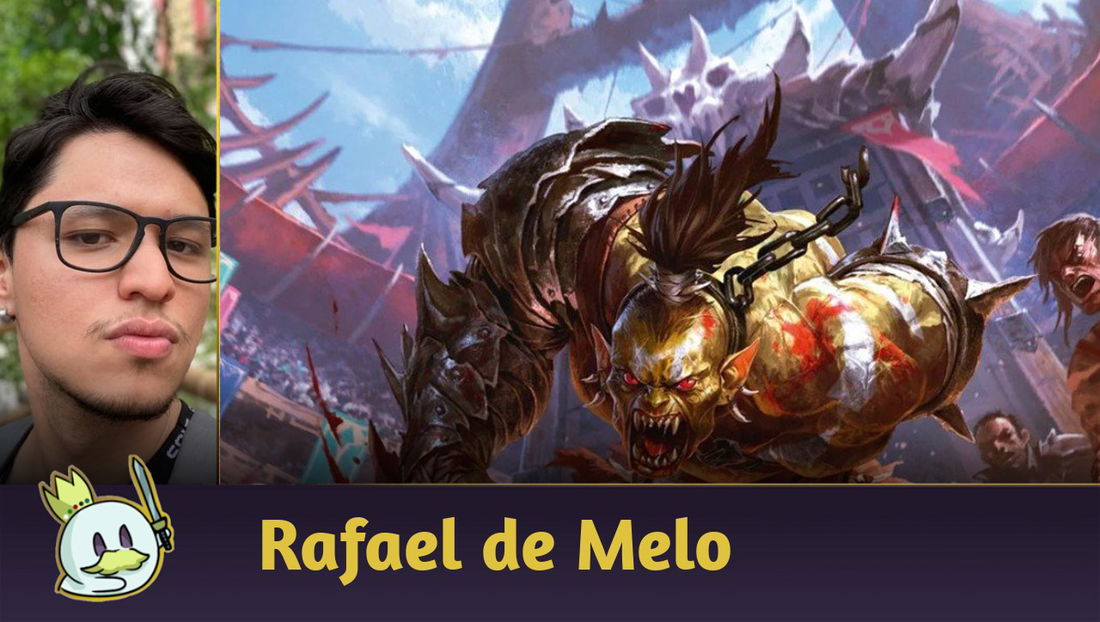Introduction
Now that we learned some advanced Flesh and Blood concepts with other articles, like the Arsenal, Equipment
, and Value and Turn Cycle
, there's still a critical concept most beginners don't pay attention to even though it can quite literally decide your matches: Pitch Stacking!
In today's article, we'll take a closer look at this concept and see how it can decide your late game.
If you're a beginner or just want to learn more about the game, I highly recommend you read the articles above to understand all of these concepts a little better.
What is a Pitch Stack?
Pitch Stack is the term we use for the way we organize the cards we use to pitch and that will go to the bottom of our deck. However, how does this actually impact the game?
Because of how the game works, eventually we'll start to draw the cards we used to pitch earlier in the game. This is what we call the "second cycle" of the game - it is when we start seeing these cards again.
Intuitively, the second cycle is always weaker than the first: we no longer have red cards (which are the main way players win with their decks), several blue cards are awful to play from our hand and the decks themselves usually lose some gas. As a result, when we play, we must always consider how important is our second cycle to that match in particular, and how much we'll depend on it to win.
Playing Around Our Second Cycle
Some decks care very little for the second cycle, be it because their strategy hardly gets to that point of the game or because they have different ways to shuffle the deck itself, which makes it impossible to pitch stack.
One of such cases is Katsu, the Wanderer. Its ability lets us tutor a card with combo, so the deck will shuffle itself, and we won't be able to pitch stack. Prism, Awakener of Sol also does the same.
However, for other decks, the second cycle might be critical when you want to close out the game. In a match between, for instance, Bravo, Showstopper and Victor Goldmane, High and Mighty, two very defensive decks, preparing your second cycle with cards like Pummel (1) and Macho Grande may be critical for your victory.
To show you how you should set up your second cycle, let's discuss one of the heroes that best does it: Teklovossen, Esteemed Magnate.
Pitching Relevant Cards
Because the Evo Steel Soul cycle (like Evo Steel Soul Memory (3), for instance) costs four, we can't equip them with only one blue card. We also need a red card, or a yellow card, but this deck doesn't use them all that much. Furthermore, this deck's game plan is to play Singularity and finish the game with this demi-hero.
Let's assume you have the following cards in your hand:

With this hand, we want to equip Evo Steel Soul Memory (3), so we need to pitch our only blue card, Junkyard Dogg (3), and a red card - but which of our red cards should we pitch?
The fact we will play our equipment isn't relevant to this choice, but we want to play around our second cycle. In it, drawing Terminator Tank (1) is much better than Scrap Trader (1), considering all its modes will be activated and it will reach its full potential.
But let's not think of only our red cards. Take a look at this example:

It is interesting, in our turn, to play Junkyard Dogg (1) and, if possible, use its scrap ability to put an Evo in our banish pile. So, let's play it, but which card should we pitch?
In practice and at a first glance, it doesn't make a difference to use Mechanical Strength (3) or Scrap Compactor (3) as resources. However, we want to play around our second cycle. Late game, when we'll already have Teklovossen, the Mechropotent, Mechanical Strength (3) will be much stronger because it is a 3-cost blue card with seven power and go again, whereas Scrap Compactor (3) won't do anything useful when we attack with it.
Having strong cards in the second cycle is the key for the decks that care about it.
Monitoring Our Second Cycle
Now, we'll delve a little deeper and see all about the complexity of the second cycle, which demands a lot of practice. For some decks, it isn't enough to just pitch certain cards for our second cycle. It is also important to know exactly which cards we used and the order they are in our deck.
Counting Our Deck
Before we get into the order of the cards we pitched, we need to know in how many turns we'll get to our second cycle, and therefore know when we'll get to it.
One of the easiest ways to know if we got to our second cycle is when we see the first card we pitched in the game. For instance, with Bravo, Showstopper, if we played Spinal Crush (1) pitching a Cranial Crush (3) and a Star Struck (2). When we put the cards in order at the bottom of our deck, we put first Star Struck (2) and then the blue card. If we memorize that the first card in our second cycle is Star Struck (2), when we find it again after we see the other two copies (considering we use three copies of it in your deck), we'll know we got to our second cycle.
Now, to know how far you are from your second cycle, you need to somewhat count your cards. According to the rules, you can't write down anything that happens in the game except your life points. So you can't write down the number of the current turn or how many cards you pitched or something like that. It will be an exercise you'll have to do entirely in your mind.
First, count how many cards you pitched in the game. If on your first turn you used two cards to pitch, and on the second three cards, you should memorize the number five. With that in mind, just run this quick math to know how far you are from your second cycle:
How far you are from your second cycle = the size of your deck right now - the number you memorized.
So, if your memorized twenty cards and your deck has thirty cards, you're ten cards away from your second cycle. To know how many turns you'll play until you reach your second cycle, just figure out this distance and divide it by your hero's intelligence, which is usually four.
Memorizing your Second Cycle
For most decks, you don't have to know the order of your cards by heart. However, during your matches, it is important to pay some attention to how you put your cards at the bottom of your deck so you don't draw, for instance, all red cards in your second cycle.
For instance, in Commoner: if your hero is Iyslander and you pitched an Aether Icevein (1), it is essential to try to add a blue Ice card to it to get the most out of it. Or, if you pitch a Sink Below (1), avoid putting another red card with it so you don't draw a bricked hand on your second cycle.
However, for some decks, it is critical to know the order you pitched your cards by heart. These decks are primarily combo decks (which play a specific sequence of cards to win the game), and the most extreme example of this in Flesh and Blood is Kano, Dracai of Aether.

If you have played Flesh and Blood for some time, you know Kano players want to win the game through Arcane damage, and they'll try to combo on their opponent's turn.
This is not the place to explain to you how to play Kano and how to pitch stack with him. The important part is to know that Kano players want to get the most out of Aether Wildfire (1) by playing many cards through its ability, and eventually end the game with his specialization, Blazing Aether (1). However, in slower matches, a Kano player should know the order they pitched their cards by heart so that they don't whiff their combo because they drew badly or because they got a bad card through his ability.
A Kano player should memorize their pitch stack by heart in matches where the second cycle matters. One example is against Guardians, which tend to use a significant number of Arcane Barriers and damage prevention, like Oasis Respite (1).
This is when the concept of a "mind palace" comes in. To sum up, it involves creating a place in your mind where you can store a few ideas and draft a game plan. So, when you enter your mind palace, you'll store away something (or its placeholder) so that every time you revisit it, it will be there with the sequence you want to remember.
This method requires practice and some time to adapt, and it is not the only one you can use to memorize your pitch stack. I highly recommend you research other techniques or try to master the "mind palace" technique. Memorizing your pitch stack may be the difference between good players and excellent players.
It is also important to remember that there are some cards that go to the bottom of your deck through effects like Sink Below (1), and you should also memorize their place in your pitch stack.
Final Words
Of all the concepts we've seen so far, pitch stacking is the most challenging one, personally, to understand and master, but it is also one of the most essential concepts.
Knowing how to play around your second cycle is essential for many decks, so it's best to train your memory when you play complex decks. You'll set up the best cards for your late game and finish the match without losing any gas.
Thank you for reading, and see you next time!














— Comentários 0
, Reações 1
Seja o primeiro a comentar